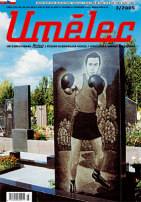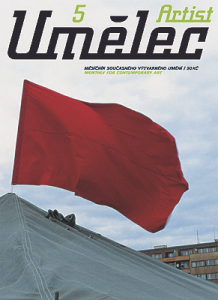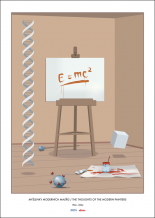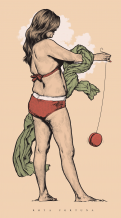| Umělec 2005/3 >> Neuropa, Inc. Europe’s Artificial Body | Просмотр всех номеров | ||||||||||||
|
|||||||||||||
Neuropa, Inc. Europe’s Artificial BodyUmělec 2005/301.03.2005 Anna Mituś | poland | en cs de es |
|||||||||||||
|
It has been almost two years since Jacques Derrida and Juergen Habermas published an appeal that the so-called “core Europe” be an “avant-garde locomotive” for a united European continent. In this appeal, published in the German Frankfurter Allgemeine Zeitung and the French La Liberation, and entitled “After the War: The Rebirth of Europe,” the authors attempted to define a new European identity up to “post national” standards, one that would define the “hegemonic unilateralism” of the United States as threatening.
Can the Poles Be Understood? An exhibition that has been wending its way through Polish regional galleries, Neuropa, Inc., reduces this or any contemporary political design to an absurdity. Curated by Kazimierz Piotrowski, an independent curator and art historian, infamous for numerous “atrocities” committed in the Polish art scene, the show expresses several artists’ skepticism not only towards global corporate culture, but also towards the blind optimism given in the utopian vision of a united future based on some vague common European tradition. From an exhibition that consists mostly of altered red and white state flags, gestures provoking regional bigotry, and the afterimages of empty landscapes of a post-communist economy entering the second phase of its underdevelopment, the traditional question needs to be asked: is it possible to understand the Poles? As a start, here’s some of the background. Piotrowski’s first scandal was 2001 in Brussels. Invited to the Europalia 2001 Poland Festival to prepare a presentation of Polish art, he organized Irreligia, a show located in two local churches and Atelier 340, a gallery owned by Wlodzimierz Majewski. That exhibition portrayed contemporary Polish art in its relation to Catholicism and recalled the history of artistic blasphemy and its critique of aspects of religious life; in that context, it caused enormous outrage. The Polish embassy demanded that the exhibition be closed; in Polish churches, mass was said pleading God’s forgiveness; and the National Museum in Warsaw immediately denied that the show had been assembled from art works from its own collection, and promptly fired Piotrowski who was director of the National Museum’s Krolikarnia gallery at the time. With his subsequent exhibitions and appearances, Piotrowski deliberately reinforced his image as half Proteus and half masochistic monster pertinaciously poisoning the fountain of faith and true values. In lectures and discussions, he would cleverly manipulate right-wing adherents of bizarre conspiracy theories. From his academic pulpit, he’d deride art critics, provided by media institutions, for their poor education, saying with literary finesse that they suffer from “sclero-catholicism.” He preferred making his own curatorial performances, adopting the role of an art “accoucheur.” In preparing his Neuropa exhibition in 2003, Piotrowski proceeded in a manner that artists considered unacceptable. Uninterested in commenting on the substance or meaning of recent Polish art, he preferred using Polish art works to examine the symptoms of the deconstruction process occurring in the symbolical sphere, concurrent with European integration. Reality is something that can be approached through language. Conscious of this, Piotrowski sought to use the exhibition as a rhetorical analysis of how corporations, institutions, and political parties appropriate the language of contemporary culture. Formulating his diagnosis, he made arbitrary use of examples to present a cross section of radical trends in Polish art over the past decade. Piotrowski punished insubordination by forced incorporation, as in the case of Cezary Bodzianowski. Despite that famous Warsaw performer’s refusal to participate in the project, he was included in the present exhibition catalog along with documentation of his artistic activities. But his name was altered maliciously to “Brodzikowski,” which is Polish for “shallow basin.” He also covered the artist’s eyes with a yellow strip, in a sarcastic attempt to keep him incognito in the media. Expectedly, this act annoyed the artist and some art critics. However, for Piotrowski, it was a necessary lesson for Bodzianowski and others on ways to apply the dialectic of art and (in)corporating tactics criticized by art. It is hard not to see a certain disquieting logic to this; with the evolution of curatorial culture, is the artist no longer the only predator in this food chain? Europe. Re-creation. Establishing a legislative base for functioning organizational super-identities has a symbolical dimension. Expressions like “legal personality,” “corporate identity” or “incorporation,” each invoke some kind of intermediate creature, an entity between ordinary mortals and the idea of law. Are we thus prepared to live our life according to “post-national” global standards? For this, Piotrowski sees a need to recognize the failure of public space confronted with the efficiency of corporate rules that enable their success—loyalty, being prepared for (work) in flexible hours, and trademark identification. Corporate culture, called by Piotrowski corporate human cultivation, requires that individuals obey an organizational discipline that is contrary to the foundation of European philosophical individualism. An obvious statement, but he would not be himself if he hadn’t struck at the most sacred values of the Catholic community. The most critical moment of the exhibition content is not so much corporate cynicism as the direct linking of market rules with those of religion, the economy of trade and economy of belief. One cannot worship both; but it is clear that in a gallery, God and Mammon can appear as two sides of the same coin. Even worse, they can be seen beyond good and evil. Evidence is supplied by many bizarre strategies not only developed by right-wing parties and Polish Catholic Radio Maria (like establishing a Polish national trademark ‘Teraz Polska’ (Poland Now) or any patriotic/spiritual mission) that use religious or national argumentation to protect Polish small businesses from bankruptcy. In this context, causing many objections by critics, the work of Stanisław Szukalski (1893 – 1987) was paraded into the exhibition. Heretic and visionary, Szukalski was the author of the Neuropa concept—a union of “fair” European countries (excluding England, France, Germany and Italy) who could be a competitor to the United States. Piotrowski labeled this political fiction, with Inc added to Szukalski’s label as an appendage, as an “allegory of the times.” Madness on the level of the European legacy and European amnesia. As many are aware (including Polish right-wing militias), Szukalski was not only fascinated by Slavonic neo-paganism; he also adhered simultaneously to fascist ideology, very popular at that period in Europe. For this very reason, the placement of Szukalski’s design for a statue of John Paul II in the middle of the exhibition made the European project seem preposterous. It is a slap in the face to politically correct audiences at a time that both right- and left-wing political parties are arguing about the identity and mission of Poles in the European Union, the expression of which was to have been in the preamble to the European constitution, invoking the name of God. With a stylized cynical gesture, the curator hopes to reduce all attempts whatsoever to take over the symbolical sphere by the confrontation of parties. Into the exhibit’s thick forest of curiosities, Piotrowski has set various eristic traps for gullible gallery visitors and catalog perusers. At face value, one might only accept Piotrowski’s bias towards the, say, art of “subterfuge” ignoring the “madness of choice,” and perhaps his postulate of art becoming “immune” to commercialization, musealization and incorporation by institutions. The New is Coming. In his way of thinking, Piotrowski belongs somewhat to a different, more “romantic” era, one somehow distanced from the fiction or abstract humor of the younger artists’ works represented in the exhibition. Standing as an interesting counterpoint to Piotrowski’s interpretation are the pseudo-abstract paintings of Kamil Kuskowski, from the Club Colors (2003) series. On narrow, horizontal canvasses, he imitates patterns of soccer fans’ scarves using them to build provocatively esthetic compositions. In doing so, he plays both with the modernistic artistic attitude and the atavism of fighting groups of fans. Juxtaposed in the touring exposition with Kuskowski are Robert Maciejuk’s cautiously and precociously exhibited, large format, vacuous political symbols that follow a similar de-semanitization process. The posters of Oskar Dawicki serve as an example of a strategy endemic to many younger artists who somehow incorporate into their work oppressive corporate energy. For two years Dawicki, a performer, member of the Supergroup Azorro, would in his famous Help series (2001/2002) affix his miniature self-portrait on posters, advertisements and other materials published by the agency where he worked. This activity remained secret until he revealed his sabotage action at an exhibition in 2002, at Warsaw’s Raster gallery. With a discrete parasitical intervention into the promotional mechanism of his corporate employer, Dawicki momentarily disrupted the functioning of all aspects of his contracted responsibilities. In doing so, the artist drew attention to the way the primary sense of communication is lost in both advertising communication and other conventional media. Playing hooky from his pictorial upbringing, Zbigniew Libera, already incorporating Piotrowski into his own media mystifications for a couple of years, presented Positives (2004) and his famous fake Lego system, which enables the construction of one’s own concentration camp (Lego, 1996). The story of this work is an example of a “happy ending” in the confrontation of art vs. corporations that fits perfectly into Piotrowski’s vision. The art work wasn’t able to represent Poland at the Venice Biennale in 1993, but it was later acquired for the Jewish Museum in New York, and the Dutch firm, Lego, which had threatened a lawsuit, withdrew its accusations. By contrast, there was no such happy ending for Rafał Jakubowicz. His work Arbeitsdisziplin (Discipline at Work) consisted of a light box photograph and a documentary video of a Volkswagen factory (seen from behind barbed wire). As a result of Volkswagen’s intervention, the work couldn’t be shown at Poznan’s Arsenal Gallery. Meticulously, Piotrowski assembled a “best of” from the breaking anti-corporate front line culminating with the documentation of an action by Pawel Althamer at the Sony Center in Berlin (2002)—an action that one might ultimately judge as a failure. As a part of a well-known corporate ritual of communing with art, Althamer offered the following: an integrating event on the patio around an oriental grill. When the proposal wasn’t accepted by the organizers, he proposed organizing an exchange of children’s playgrounds between Warsaw’s poor Brudno district and Sony corporation. Because none of his ideas were accepted, the artist finally arranged (according to the strict rule “no performance – no money”) a meeting at Potzdamer Square, to which he arrived in a business suit—a uniform complete with mobile phone and other required accessories. The documentation by Krzysztof Visconti presented in the Neuropa, Inc exhibition shows some initial moments of this controlled act of disobedience. Althamer took off his clothes and departed to “an undisclosed location.” Nevertheless, the artist received strict instructions from Sony to keep his underwear on, and he was not completely naked. Fault-Finders and a Harlot. Many of the works presented in the exhibition have been included by Polish art critics in the particularly Polish category of sztuka krytyczna (critical art), referring to art describing a field of tension between social engagement and newer conceptions of social or anthropological discourse in the country after 1989. Piotrowski passed over that turning point that had become a peculiar “zero hour“ for understanding the recent Polish artistic scene; he merged into his “critical” exhibition works by artists such as Andrzej Partum, Józef Robakowski, Przemysław Kwiek or Jan Swidziński whose socially engaged art analyzed problems of discourse medialization, cultural representation of the body, and the “hoodwinking” of the public sphere by institutions long before promoting the rubric of “critical art.” There may be nothing specific to Poland about the strategies associated with “critical art,” but its significance has been enhanced with its rejection by audiences shocked by recent artistic strategies. Piotrowski illustrates the infantile character of the confrontation between contemporary art, the majority of Catholic audiences and the Polish legal system by incorporating the trial of Dorota Nieznalska into the exhibition. The young artist from Gdańsk had been accused by a local court and found guilty of offending the religious sensibilities of many people, upset by Passion (2001), her installation at an exhibition at the Wyspa gallery of a cross-shaped object with a photo of male genitalia juxtaposed with a man training in a gym. The court’s judgment inspired merely a mild response from intellectuals and artists opposing restrictions on artistic expression. The work entitled On Behalf of the Polish Republic, (2004) is a fragment of a video from Nieznalska’s trial at sentencing, with the Polish catholic liturgical quotation, “The sacrifice is done, go in peace” as a caption. Here, Piotrowski comments on the issue of public and nationalized brands of her work in a global perspective, as well as on the weakness of her own environment in which interests and rights are not represented in legal space in any effective way. Art is Made for You. Your limitations are the limitations of art; your language is art’s language. One can say that by looking at this unique mixture of a collapse of ideals and fetishistic ambitions mirrored in art. Art can be amusing if it is clever. Examples are the works of Jerzy Kosałka, Hanna Kosewicz, Krzysztof Wałaszek, or the artistic groups, Twożywo (Mariusz Libel, Krzysztof Sidorek) and Łódz Kaliska (Marek Janiak, Andrzej Kwietniewski, Adam Rzepecki, Andezej Swietlik, Andrzej Wielogorski), who have in common what I call a kind of subversive social mimicry. When you are laughing you are already on the other side of art’s funhouse mirror. The work of the Łódz Kaliska group is a good example of the change that has transpired in Polish art since 1989. The group used to be one of Poland’s most important artistic groups in the 80s. After its counterculture projects kultura zrzuty (the Chip-in Culture) and sztuka zenujaca (Embarassing Art), the time has come for a return to the bosom of society: the establishment of an idea of “New Pop.” Facing possible accusations of sexism, the group members used their New- Pop-manifesto to propose a project for a new Polish national emblem, an eagle—an attractive naked she-eagle reproduced on the cover of the Polish Playboy magazine. With this and many other insolent projects, like a refrigerator for women who have passed their prime, the group stands against correctness and polite openness, and the abridging of art interpretation to gender issues. The works by Twożywo are different. Stylized as a market product card, Mariusz Libel and Krzysztof Sidorek developed a Maria Materia credit card complete with a professional marketing strategy legitimizing the project, and a website offering customer service for people who “use” the Maria Materia card. They advertise it as “the first card enabling you to enjoy your life without feeling responsible for your activities,” and in the FAQ for “service” they answer the unavoidable question: “In the case your card doesn’t work – believe in it.” This pseudo-positive symbiosis between the art and consumer pop-culture harmonizes somehow with the critical moment of Piotrowski’s ironical questioning of the “delirium of freedom in art.” In effort to adjust to you, artists don’t want to be just artists any longer, and they don’t want more freedom. They want to offer more to you. “Is an anti-corporate movement possible in art?” asks Piotrowski his catalog Inc. since artists functioning in the gallery system depend on both public support and on media concerns? It seems that to address such a question, one needn’t answer. And certainly not the artists themselves who have not lived in an ivory tower for a long time, despite efforts to maintain the appearance of public support for art. Producing their works, criticized for their journalistic approach, they appeal to your sense of freedom, and sometimes to your sense of humor, which forms freedom’s “fringes.” Laughing in the gallery, don’t forget, the one who laughs last laughs best.
01.03.2005
Рекомендуемые статьи
|
|||||||||||||
|
04.02.2020 10:17
Letošní 50. ročník Art Basel přilákal celkem 93 000 návštěvníků a sběratelů z 80 zemí světa. 290 prémiových galerií představilo umělecká díla od počátku 20. století až po současnost. Hlavní sektor přehlídky, tradičně v prvním patře výstavního prostoru, představil 232 předních galerií z celého světa nabízející umění nejvyšší kvality. Veletrh ukázal vzestupný trend prodeje prostřednictvím galerií jak soukromým sbírkám, tak i institucím. Kromě hlavního veletrhu stály za návštěvu i ty přidružené: Volta, Liste a Photo Basel, k tomu doprovodné programy a výstavy v místních institucích, které kvalitou daleko přesahují hranice města tj. Kunsthalle Basel, Kunstmuseum, Tinguely muzeum nebo Fondation Beyeler.
|









































 We Are Rising National Gallery For You! Go to Kyjov by Krásná Lípa no.37.
We Are Rising National Gallery For You! Go to Kyjov by Krásná Lípa no.37.
Комментарии
Статья не была прокомментированаДобавить новый комментарий